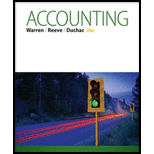
(a)
Bonds Payable: Bonds payable are referred to long-term debts of the business, issued to various lenders known as bondholders, generally in multiples of $1,000 per bond, to raise fund for financing the operations.
Premium on bonds payable: It occurs when the bonds are issued at a high price than the face value.
Effective-interest method of amortization: It is an amortization model that apportions the amount of bond discount or premium based on the market interest rate.
Present Value: The value of today’s amount expected to be paid or received in the future at a compound interest rate is called as present value.
To calculate: The amount of cash proceeds (present value) from the sale of the bonds.
(b)
To calculate: The amount of premium to be amortized for the first semiannual interest payment period.
(c)
To calculate: The amount of premium to be amortized for the second semiannual interest payment period.
(d)
The amount of bond interest expense for first year.
Trending nowThis is a popular solution!

Chapter 14 Solutions
Accounting (Text Only)
- An asset owned by Crescent Manufacturing has a book value of $36,000 on June 30, Year 5. The asset has been depreciated at an annual rate of $8,000 using the straight-line method. Assuming the asset is sold on June 30, Year 5 for $39,500, how should the company record the transaction? a. Neither a gain nor a loss is recognized on this type of transaction. b. A gain on sale of $3,500. c. A gain on sale of $5,000. d. A loss on sale of $3,500. e. A loss on sale of $5,000.arrow_forwardI need help with this general accounting problem using proper accounting guidelines.arrow_forwardAccounting answer pleasearrow_forward
- For the year, Rochester Industries has a cost of goods manufactured of $850,000, beginning finished goods inventory of $210,000, and ending finished goods inventory of $185,000. What is the cost of goods sold? A. $620,000 B. $670,000 C. $700,000 D. $875,000arrow_forwardPlease explain the solution to this financial accounting problem using the correct financial principles.arrow_forwardTrevor sold a stock for $12,400. The price at the time of purchase was $7,800. He paid a commission to his broker of $425. How much is Trevor's amount realized? Need answerarrow_forward
- I am trying to find the accurate solution to this general accounting problem with appropriate explanations.arrow_forwardI am searching for a clear explanation of this financial accounting problem with valid methods.arrow_forwardTrevor sold a stock for $12,400. The price at the time of purchase was $7,800. He paid a commission to his broker of $425. How much is Trevor's amount realized?arrow_forward

 AccountingAccountingISBN:9781337272094Author:WARREN, Carl S., Reeve, James M., Duchac, Jonathan E.Publisher:Cengage Learning,
AccountingAccountingISBN:9781337272094Author:WARREN, Carl S., Reeve, James M., Duchac, Jonathan E.Publisher:Cengage Learning, Accounting Information SystemsAccountingISBN:9781337619202Author:Hall, James A.Publisher:Cengage Learning,
Accounting Information SystemsAccountingISBN:9781337619202Author:Hall, James A.Publisher:Cengage Learning, Horngren's Cost Accounting: A Managerial Emphasis...AccountingISBN:9780134475585Author:Srikant M. Datar, Madhav V. RajanPublisher:PEARSON
Horngren's Cost Accounting: A Managerial Emphasis...AccountingISBN:9780134475585Author:Srikant M. Datar, Madhav V. RajanPublisher:PEARSON Intermediate AccountingAccountingISBN:9781259722660Author:J. David Spiceland, Mark W. Nelson, Wayne M ThomasPublisher:McGraw-Hill Education
Intermediate AccountingAccountingISBN:9781259722660Author:J. David Spiceland, Mark W. Nelson, Wayne M ThomasPublisher:McGraw-Hill Education Financial and Managerial AccountingAccountingISBN:9781259726705Author:John J Wild, Ken W. Shaw, Barbara Chiappetta Fundamental Accounting PrinciplesPublisher:McGraw-Hill Education
Financial and Managerial AccountingAccountingISBN:9781259726705Author:John J Wild, Ken W. Shaw, Barbara Chiappetta Fundamental Accounting PrinciplesPublisher:McGraw-Hill Education





